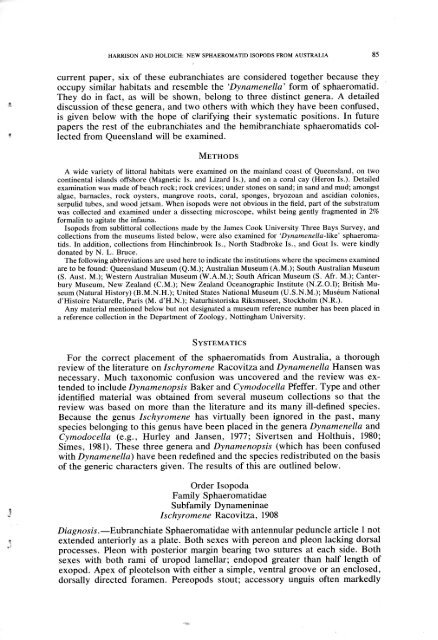Download PDF as one large file
Download PDF as one large file
Download PDF as one large file
Create successful ePaper yourself
Turn your PDF publications into a flip-book with our unique Google optimized e-Paper software.
HARRISON AND HOLDICH: NEW SPHAEROMATID ISOPODS FROM AUSTRALIA 85<br />
current paper, six of these eubranchiates are considered together because they<br />
occupy similar habitats and resemble the 'Dynamenella' form of sphaeromatid.<br />
They do in fact, <strong>as</strong> will be shown, belong to three distinct genera. A detailed<br />
discussion of these genera, and two others with which they have been confused,<br />
is given below with the hope of clarifying their systematic positions. In future<br />
papers the rest of the eubranchiates and the hemibranchiate sphaeromatids collected<br />
from Queensland will be examined.<br />
METHODS<br />
A wide variety of littoral habitats were examined on the mainland co<strong>as</strong>t of Queensland, on two<br />
continental islands offshore (Magnetic Is. and Lizard Is.), and on a coral cay (Heron Is.). Detailed<br />
examination w<strong>as</strong> made of beach rock; rock crevices; under st<strong>one</strong>s on sand; in sand and mud; amongst<br />
algae, barnacles, rock oysters, mangrove roots, coral, sponges, bryozoan and <strong>as</strong>cidian colonies,<br />
serpulid tubes, and wood jetsam. When isopods were not obvious in the field, part of the substratum<br />
w<strong>as</strong> collected and examined under a dissecting microscope, whilst being gently fragmented in 2%<br />
formalin to agitate the infauna.<br />
Isopods from sublittoral collections made by the James Cook University Three Bays Survey, and<br />
collections from the museums listed below, were also examined for 'Dynamenella-like" sphaeromatids.<br />
In addition, collections from Hinchinbrook Is., North Stadbroke Is., and Goat Is. were kindly<br />
donated by N. L. Bruce.<br />
The following abbreviations are used here to indicate the institutions where the specimens examined<br />
are to be found: Queensland Museum (Q.M.); Australian Museum (A.M.); South Australian Museum<br />
(S. Aust. M.); Western Australian Museum (W.A.M.); South African Museum (S. Afr. M.); Canterbury<br />
Museum, New Zealand (CM.); New Zealand Oceanographic Institute (N.Z.O.I); British Museum<br />
(Natural History) (B.M.N.H.); United States National Museum (U.S.N.M.); Museum National<br />
d'Histoire Naturelle, Paris (M. d'H.N.); Naturhistoriska Riksmuseet, Stockholm (N.R.).<br />
Any material menti<strong>one</strong>d below but not designated a museum reference number h<strong>as</strong> been placed in<br />
a reference collection in the Department of Zoology, Nottingham University.<br />
SYSTEMATICS<br />
For the correct placement of the sphaeromatids from Australia, a thorough<br />
review of the literature on Ischyromene Racovitza and Dynamenella Hansen w<strong>as</strong><br />
necessary. Much taxonomic confusion w<strong>as</strong> uncovered and the review w<strong>as</strong> extended<br />
to include Dynamenopsis Baker and Cymodocella Pfeffer. Type and other<br />
identified material w<strong>as</strong> obtained from several museum collections so that the<br />
review w<strong>as</strong> b<strong>as</strong>ed on more than the literature and its many ill-defined species.<br />
Because the genus Ischyromene h<strong>as</strong> virtually been ignored in the p<strong>as</strong>t, many<br />
species belonging to this genus have been placed in the genera Dynamenella and<br />
Cymodocella (e.g., Hurley and Jansen, 1977; Sivertsen and Holthuis, 1980;<br />
Simes, 1981). These three genera and Dynamenopsis (which h<strong>as</strong> been confused<br />
with Dynamenella) have been redefined and the species redistributed on the b<strong>as</strong>is<br />
of the generic characters given. The results of this are outlined below.<br />
OrderIsopoda<br />
Family Sphaeromatidae<br />
Subfamily Dynameninae<br />
Ischyromene Racovitza, 1908<br />
Diagnosis.—Eubranchiate Sphaeromatidae with antennular peduncle article 1 not<br />
extended anteriorly <strong>as</strong> a plate. Both sexes with pereon and pleon lacking dorsal<br />
processes. Pleon with posterior margin bearing two sutures at each side. Both<br />
sexes with both rami of uropod lamellar; endopod greater than half length of<br />
exopod. Apex of pleotelson with either a simple, ventral groove or an enclosed,<br />
dorsally directed foramen. Pereopods stout; accessory unguis often markedly

















